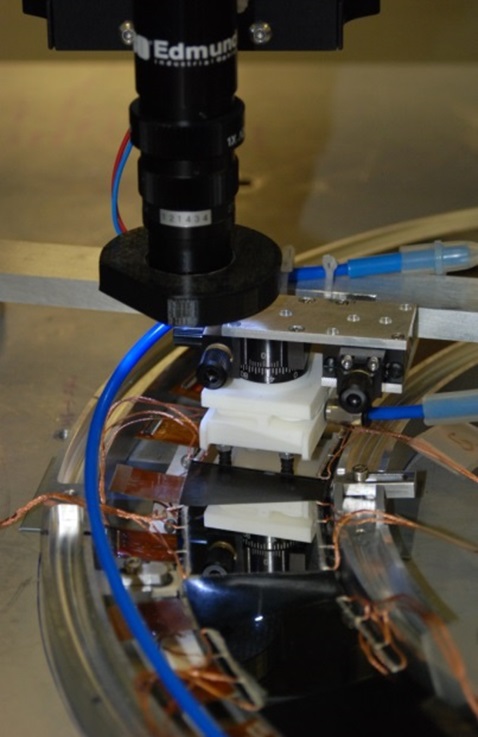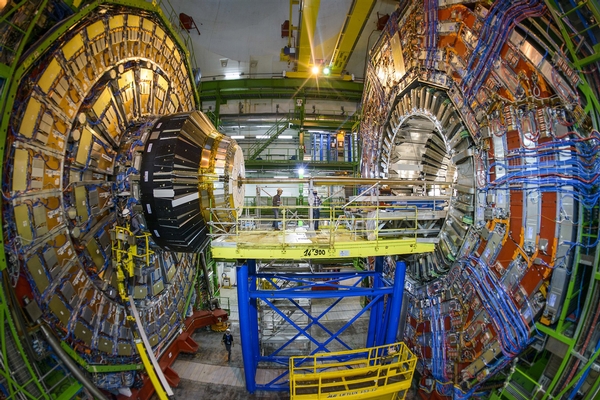Full details of how to apply can be found from our main Summer Student page.
Dates
We require completed CVs, along with a Letter of Recommendation from your university tutor, by 21st February 2019.
Projects
Possible projects include the following.
Feel free to tell us in your CV in which projects you would be particular interested (can be one or more). If you have no strong preference, that is fine. We will be looking for the best students and will try to match them up to suitable projects.
Search for Long-lived Decaying Particles in ATLAS
The ATLAS Group at RAL is involved in physics searches for phenomena which involving long-lived particles, which will decay in the detector. These will leave a distinct signature of two leptons coming from a common point situated in the tracking detector. Searches are ongoing for such particles in the data taken in the last years. Also the future prospects for these searches with the upgraded detectors are being studied. The summer student will use simulations to study the reconstruction of these electrons or muons and help in the optimisation of finding the origin of this 2-lepton signature in the detector while minimising the rate of fake 2-lepton signals for current and/or future physics data. For this task he/she will use C++ and/or Python code to analyse the output of the ATLAS reconstruction software suite.
Proposed Dates: 8 week in the period between June to end of August
Student Specification: The student should have interest in computing, but no deep prior knowledge of C++ or Python is required.
The ATLAS Tracker Upgrade – Pixel Detector DAQ
In 2026, the ATLAS Detector at CERN, as well as the Large Hadron Collider, will restart after an upgraded with state-of-the-art technology, to provide new opportunities for particle physics research. The ATLAS Detector will have a new tracking detector, the ITk. The ATLAS Group at RAL is involved in the design and construction of this detector.
At RAL, ITk sensors comprising of silicon pixel modules are to be attached to lightweight carbon-fibre ITk support structures. Modules must be placed on the supports with a precision of the order of 10 microns, and then tested with a high-speed data acquisition (DAQ) system utilising field-programmable gate arrays (FPGAs).
The student will assist in the electrical testing of modules for the ITk. The placement of modules uses a camera-and-laser-guided gantry system. Currently, these various systems require a great deal of manual intervention during their use. The student will help to develop computer programs for the automation of these systems.
The student will gain experience with Silicon pixel sensor technology, high-speed electronics, FPGAs and associated software, as well as precision engineering and control of associated errors. The student will also gain an education in modern tracking detector design for particle physics.
Proposed Dates: 8 weeks between June and the end of August
Student Specification: The student will make use of Python, C++, and LabView. Prior familiarity with any of these will be advantageous, but is not a requirement. Some programming experience, as well as a careful and patient approach to problem solving, will be required.
ATLAS Tracker Upgrade: Pixel Endcap Assembly
The Upgraded ATLAS Pixel Tracker will be the biggest pixel detector system ever built, with over a billion detector channels. At RAL, we will be a key player in the assembly of the Pixel Endcaps for the Tracker Upgrade. RAL will assemble hybrid pixel detector modules onto lightweight carbon fibre half-rings for the Upgrade.
ATLAS Pixel Tracker will be the biggest pixel detector system ever built, with over a billion detector channels. At RAL, we will be a key player in the assembly of the Pixel Endcaps for the Tracker Upgrade. RAL will assemble hybrid pixel detector modules onto lightweight carbon fibre half-rings for the Upgrade.
Over the next few months, we will continue our work on precision placement of detector modules onto the half-rings. We seek a student to undertake refinement of placement methods, and measurement of the achievable placement accuracy. This will be carried out using our high-precision motorised gantry system, equipped with a camera, laser displacement sensor and adhesive dispense system.
Specific tasks include calibrating the accuracy of the gantry itself, using a laser interferometer and comparing the gantry to a coordinate measuring machine by surveying standard test objects. We will look at the automation of vacuum switching between the vacuum chucks in the system, to handle detector modules in a more automated way. We will build prototype detector assemblies, which will be tested by our collaborators to verify the electrical and cooling system design for the Upgrade. We will carry out trials with different candidate adhesives and dispensing methods, assembling dummy and mechanical grade components.
As part of the work, we must be able to test the electrical functionality of the detector modules before and after mounting to the half-ring structure. We also intend to develop the testing of partially assembled modules on a semiconductor probe station.
Student Specification: We seek a dextrous student with good practical skills and patience. Some programming experience is needed for control of equipment and analysis of results. A basic understanding of experimental errors and statistics is important, as is basic mathematical proficiency. Experience of Labview software, Arduino or Raspberry Pi would be useful, but is not essential.
ATLAS High-Level Trigger
The ATLAS Trigger system makes fast real-time decisions on whether to keep data from interesting proton-proton collision events at the LHC to be studied later, or discard them. We can only keep about 1 in 100,000 collisions. The High-Level Trigger (HLT) includes fast software algorithms that process information from the Inner Detector to find charged-particle tracks. Because of the huge number of particles produced in LHC collisions, the Inner Detector tracking software uses a lot of computing power – almost half of the HLT computing resources are used to reconstruct tracks in real time.
The RAL HLT group works on several projects to improve this performance, including technical changes to the software, new algorithms to reduce processing time and using information from new custom track-finding hardware. You will implement improvements to the software and measure the changes. You should have an interest in computing with some experience of programming in C++ or a similar language. Some knowledge of ROOT would be helpful but is not essential.
Track-finding in FPGAs
From 2026, the Large Hadron Collider will be colliding protons at such a high rate that the CMS detector must be upgraded to cope. In particular, the Level 1 trigger, whose purpose is to identify interesting collisions within a few microseconds of them taking place, must be significantly improved. We wish to reconstruct, on this very short time-scale, the trajectories of the numerous charged particles produced in each LHC collision. We will do this using high-speed programmable electronics (FPGAs). This is a very challenging project, and research is underway here to optimise our proposed solution.
The student will use C++ software running on simulated LHC collision events to optimise the algorithms used to reconstruct the particle trajectories. Since these algorithms must ultimately be run in the electronics, the student will need to keep them as simple as possible, and understand the limitations and strengths of the electronics. The possibility of programming the FPGAs using the HLS language (similar to C++) is also available.
Proposed Dates: 8 weeks during a period to be agreed from June to August.
Student Specification: You need a logical mind and should be familiar with computer programming, and ideally with C++. An interest in particle physics or electronics would be a bonus.
Implementation of Neural Nets in FPGAs
From 2026, the Large Hadron Collider will be colliding protons at such a high rate that the CMS detector must be upgraded to cope. In particular, the Level 1 Trigger, whose purpose is to identify interesting collisions within a few microseconds of them taking place, will be significantly improved. This trigger is able to carry out complex algorithms within a few microseconds by making use of cutting-edge high-speed programmable logic (FPGAs). It is possible to implement neural nets (NN) on these FPGAs. The project will be to implement NN on FPGAs by making use for HLS to translate C++ into the firmware that is used on FPGAs.
Implementation of Vertex-finding in FPGAs
From 2026, the Large Hadron Collider will be colliding protons at such a high rate that the CMS detector must be upgraded to cope. In particular, the Level 1 Trigger, whose purpose is to identify interesting collisions within a few microseconds of them taking place, will be significantly improved. This trigger is able to carry out complex algorithms within a few microseconds by making use of cutting-edge high-speed programmable logic (FPGAs). One of the tasks that must be carried out in the FPGAs is to find the position in space where the protons have collided. The project will be to develop such a "vertex" finding algorithm and implement it on an FPGA using HLS to translate from C++ to the firmware that is used on FPGAs.
Simulation Studies for Future Dark Matter Experime![]() nts
nts
The nature of dark matter is one of the open and fundamental questions in physics, and the dark matter experiments using liquid xenon are at the forefront of technology designed to pursue this question. While constructing the LUX-Zeplin experiment, we are planning an R&D programme for a future large G3 experiment using liquid xenon. As part of these activities, we would like to model and simulate low-energy events arising from electrons and nuclear recoils, enabling us to extend dark-matter searches and experiment sensitivity towards even lower mass (< 1 GeV) WIMPs. The success of a future G3 experiment will depend on a careful understanding of the response of the detector to low energy events.
The student will use simulation packages such as SRIM, garf++, Magboltz and Degrad to study generation, energy deposition and reconstruction of low energy particles in liquid xenon.
Student Specification: You should have an interest in particle physics and computing, with some experience of programming in C. Some knowledge of ROOT would be helpful but is not essential.
Low Background Material Studies at the Boulby Underground Laboratory
The Boulby Underground Laboratory is situated 1.1 km underground at Boulby Mine in the North-East of England. The Boulby Underground Germanium Suite (BUGS) comprises 7 low and ultra-low background germanium detectors that are used to characterise the radioactivity of materials that are used in current particle physics experiments and will be used in next generation low-background searches. The student will be involved in all aspects of material screening, including sample preparation, data acquisition, simulation and analysis. This will be a unique opportunity to work in the UK's deepest underground laboratory.
Student Specification: The student would ideally have some experience in the use of germanium detectors and have some experience of programming in C. Some knowledge of ROOT would be helpful but is not essential.
NOTE: This project would be located at the Boulby Mine near Whitby … a long way from the Rutherford Lab! it's an incredible experience working 1 km underground inside a clean room in a potash mine.
